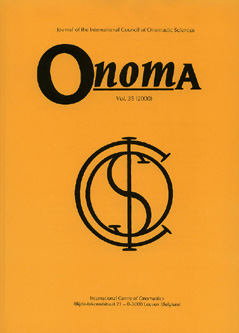 previous article in this issue previous article in this issue | next article in this issue  |

Preview first page |
Document Details : Title: Presence and Persistence of Basque Toponymy in Catalan Pyrenees Subtitle: Some Geographical Questions Author(s): TORT-DONADA, Joan Journal: Onoma Volume: 46 Date: 2011 Pages: 97-125 DOI: 10.2143/ONO.46.0.2975531 Abstract : The existence of Basque place names extending across the Pyrenees from west to east (from the Bay of Biscay to the Mediterranean Sea, and some three hundred kilometres beyond the political boundary of the Basque Country) is one of the most interesting questions being examined today in the historical onomastics of the Iberian Peninsula. Given the exceptional nature of the Basque language on the linguistic map of Europe (in particular, its non-Indo-European origin), the presence and persistence of Basque toponymy (place names that can be described as being 'Basque' or having a linguistic root that might historically be related to this language) throughout the Pyrenees mountain range raises important questions associated with the ancient settlement pattern of all this region (in terms of its Human Geography). In this context, the article undertakes a study of a selection of Basque and proto-Basque toponyms in the western sector of the Catalan Pyrenees, specifically, in the region of Ribagorza (generally considered the most conservative, linguistically speaking, in the whole of Catalonia). Against this background, the article focuses on those toponyms that are most closely related to the geography. In particular, it raises the question of the persistence of toponyms of this type over the ages (and, even, across different language systems). Special consideration is given to aspects associated with the original 'spatial meaning' of toponyms, and with the geographical link between “names” and 'places' (in terms, for instance, of location: cross-roads, fords of rivers, high-mountain grazing areas, etc.). L’existence de noms de lieux basques tout au long des Pyrénées d’Ouest en Est (depuis la baie de Biscaye jusqu’à la mer Méditerranée, et quelques trois cent kilomètres au delà de la frontière politique du Pays Basque) est une des plus intéressantes questions actuellement étudiées dans l’onomastique historique de la péninsule Ibérique. Étant donné la nature exceptionnelle de la langue basque sur la carte linguistique de l’Europe (en particulier, son origine non indo-européenne), la présence et la persistance de la toponymie basque (des noms de lieux qui peuvent être identifiés comme «basques» ou avoir une racine linguistique qui peut être reliée historiquement à ce langage) à travers la variété et l’étendue des montagnes pyrénéennes soulèvent d’importantes questions liées à l’ancienneté du peuplement de toute cette région (en termes de Géographie Humaine). Cet article entreprend une étude de certains de ces toponymes basques et proto-basques dans le secteur ouest des Pyrénées catalanes, plus spécifiquement la région de Ribagorza (généralement considérée comme une des plus conservatrices, linguistiquement parlant, de la Catalogne). Dans ce contexte, l’article se focalise sur les toponymes qui sont plus précisément liés à la géographie. Et, en particulier, il soulève la question de la persistance des toponymes de ce type à travers les âges (et même à travers différents systèmes de langage). Une attention spéciale est apportée à des aspects concernant la «signification spatiale» originelle des toponymes et le lien géographique entre «noms» et «lieux» (en termes, par exemple, de localisation: croisements, gués, zones de pâturages en haute montagne, etc.). Das Vorkommen baskischer Ortsnamen in den Pyrenäen von West nach Ost (vom Golf von Biskaya bis zum Mittelmeer, und einige 300 Kilometer jenseits der politischen Grenzen des Baskenlandes) ist eine der interessantesten Fragen, mit der sich die historische Onomastik auf der Iberischen Halbinsel derzeit beschäftigt. Angesichts der außergewöhnlichen Natur der baskischen Sprache in der sprachlichen Landschaft Europas (insbesondere ihres nicht-indoeuropäischen Ursprungs) wirft die Präsenz und die Persistenz baskischer Ortsnamen (d.h. jene Namen, die entweder direkt als 'Baskisch' gelten oder durch linguistische Wurzeln historisch mit dieser Sprache verbunden sein könnten) in den Pyrenäen wichtige Fragen im Zusammenhang mit den antiken Siedlungsmustern aller dieser Regionen auf. In diesem Zusammenhang untersucht dieser Beitrag eine Auswahl baskischer und protobaskischer Ortsnamen in den westlichen Sektoren der katalanischen Pyrenäen (bzw. in Ribagorza, einer Region, die sprachlich als die konservativste in ganz Katalonien gilt). Vor diesem Hintergrund konzentriert sich der Artikel auf Ortsnamen, die am engsten mit der Geographie verbunden sind. Und vor allem stellt sich die Frage nach der Langlebigkeit von Ortsnamen dieser Art über viele Jahrhunderte (und über unterschiedliche Sprachsysteme hinweg). Besondere Berücksichtigung finden dabei Aspekte, die die ursprüngliche 'räumliche Bedeutung' der Ortsnamen und besonders das geographische Verbindungsglied zwischen 'Namen' und 'Orten' betreffen (beispielsweise hinsichtlich ihrer Lage, wie im Fall von Straßenkreuzungen, Flussübergängen, Hochgebirgsweideflächen usw.). |
|


